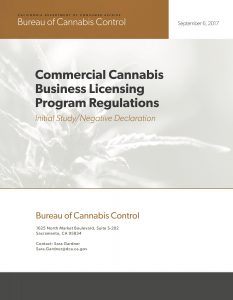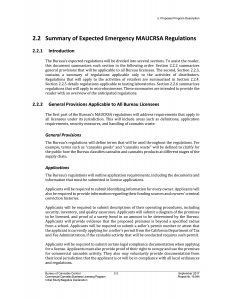Summary of Expected Emergency MAUCRSA Regulations Released
The Bureau of Cannabis Control (Bureau), formerly named the Bureau of Medical Cannabis Regulation, is developing regulations pursuant to the Medicinal and Adult-Use Cannabis Regulation and Safety Act (MAUCRSA) to establish a regulatory licensing and enforcement program for commercial cannabis distributors, retailers, testing laboratories, and microbusinesses. As lead agency under the California Environmental Quality Act (CEQA), the Bureau has prepared an Initial Study/Proposed Negative Declaration (IS/ND). The entire document can be downloaded by clicking the image below.
The Initial Study/Proposed Negative Declaration (IS/ND) is huge at 491 pages; however, it contains a very helpful Summary of Expected Emergency MAUCRSA Regulations. The official summary can be downloaded by clicking the image below.
The Summary of Expected Emergency MAUCRSA Regulations can also be downloaded here. This official summary provides a helpful preview to those who want to plan to comply with the anticipated MAUCRSA regulations.
Highlights of the expected regs:
Applicants will be required to submit identifying information for every owner. Applicants will also be required to provide information regarding their funding sources and owners’ criminal conviction histories.
In the regulations, the Bureau will specify the types of records that licensees must keep, including financial, personnel, and security records; training records; contracts; and permits, licenses, and local business authorizations. The regulations will require that these records can be produced when requested by the Bureau.
Licensees and persons acting for or employed by a licensee must display photo identification badges while engaging in any commercial cannabis activity. isitors to any licensed premises will be required to be escorted by an employee when visiting limited‐access areas of the premises.
All licensees will be required to install and maintain a video surveillance system to record all entries and exits, as well as all areas where cannabis is received, processed, and stored, as well as security rooms. Retailers will also be required to record all point‐of‐sale areas and areas where cannabis is displayed for sale. Cameras must record 24 hours per day, and recordings must be kept for a specified period of time.
Licensed premises will have an alarm system that is monitored and maintained by a licensed alarm company.
Distributors are also the only license type that can transport commercial cannabis goods. Distributors may act as wholesalers or may charge other licensees a fee for conducting distribution on their behalf.
The regulations will provide that distributors may package and label or repackage and relabel cannabis in the form of dried flower on behalf of a cultivator or another distributor. Distributors may not package, repackage, label, or relabel manufactured cannabis goods.
Cannabis goods will be required to be transported inside commercial vehicles or trailers. Transportation may not be done by aircraft, watercraft, rail, drones, human powered vehicles, or unmanned vehicles.
Vehicles used for transporting cannabis goods must contain a box that can be locked and that is secured to the inside of the vehicle or trailer. Cannabis goods must be locked in the box during transport.
After taking physical possession of a cannabis batch, a distributor will contact a licensed testing laboratory to arrange for testing, unless the distributor plans to sell the batch to another distributor. At that point, a laboratory agent will come to the distributor’s licensed premises to take a sample. The sample selection will be recorded on video, and both the distributor and the laboratory agent must witness and attest to the sample selection.
After the sample has been tested, the testing laboratory will provide the distributor with a certificate of analysis. If a sample passes testing, the distributor may transport the cannabis goods to one or more retailers for sale. If a harvest batch fails testing, it can be remediated for use in a manufactured product, if doing so would not result in harm to consumers.
Cannabis goods may be displayed only in the retail area, and only during business operating hours. Cannabis goods may not be displayed where visible from outside the premises.
Retailers may not provide free samples to anyone or allow representatives of other companies or organizations to provide free samples on the licensed premises.
Retailers must receive cannabis goods only from licensed distributors. Cannabis goods must be packaged and labeled for final sale at the time the retailer receives them.
Following a sale, the retailer must place cannabis goods in an opaque exit package before the customer leaves the retailer premises.
Delivery employees may not consume cannabis during delivery.
Vehicles used for delivery must have a dedicated, active GPS device that enables the dispensary to identify the geographic location of the vehicle during delivery.
Retailers may receive shipments of inventory only from licensed distributors.
Retailers must keep records of all sales transactions, including the names of the sales employee and the customer, the list and quantity of products sold and their price, and the date and time of the transaction.
The Bureau’s regulations will include a grace period for compliance with packaging and testing requirements. During the grace period, retailers may package and sell cannabis goods that have not been packaged by a cultivator or distributor. In addition, during the same time frame, retailers may sell untested cannabis if they place a label on the package with the date of purchase and the statement, “This product has not been tested under the Medicinal and Adult‐Use Cannabis Regulation and Safety Act.”
Laboratories will be required to test samples for cannabinoid content. The cannabinoids that are required to be tested for are tetrahydrocannabinol (THC), tetrahydrocannabinolic acid (THCA), cannabidiol (CBD), cannabidiolic acid (CBDA), cannabigerol (CBG), and cannabinol (CBN). For each of these cannabinoids, laboratories must report the concentration. They may also test for other cannabinoids at the election of the test requester.
Laboratories will be required to analyze samples of manufactured cannabis goods for residual solvents and processing chemicals. Dried flower, kief, and hashish need not be analyzed for residual solvents.
Testing laboratories will be required to test samples for residual pesticides.
Laboratories will be required to test samples of cannabis and cannabis products for microbiological impurities, which will include Shiga toxin producing Escherichia coli and Salmonella spp. Laboratories must also test for the pathogenic species Aspergillus funigatus, A. flavus, A. niger, and A. terreus in all cannabis goods intended for consumption by inhalation, including dried flower, kief, hashish, oil, and waxes.
Testing laboratories will be required to analyze samples for mycotoxins.
Testing laboratories will analyze dried flower harvest batch samples for water activity and moisture content.
Testing laboratories will be required to test samples for filth and foreign material. This includes, but is not limited to, mold, hair, insects, feces, packaging contaminants, and manufacturing waste and byproducts. Samples that contain these contaminants above the specified action levels will fail laboratory testing.
Laboratories may be required to analyze samples for concentrations of heavy metals.
After completion of testing, the testing laboratory will issue a certificate of analysis that details the results of each test. The certificate of analysis will also report whether the laboratory detected any unknown or unidentified substances or materials during analysis of a sample. If the laboratory finds a contaminant that is not listed in these regulations that could be injurious to human health at the levels detected, the laboratory must notify the Bureau within 24 hours. Samples found to contain synthetic cannabinoids will fail testing.
A batch may not be retested unless it has undergone a remediation process. Before a batch can be retested, the distributor must provide a document to the laboratory specifying how the product was remediated.
Testing laboratories will be required to develop and implement a laboratory quality assurance program
A microbusiness license allows the licensee to cultivate cannabis in an area of less than 10,000 square feet and to act as a licensed distributor, Level 1 (nonvolatile solvent) manufacturer, and retailer. (Bus. Prof. Code §26070.) For both medicinal and adult‐use cannabis operations, CDFA is the licensing authority for stand‐alone cannabis cultivation activities and CDPH is the licensing authority for stand‐alone cannabis manufacturing activities.
With regard to distribution and retail sale, the regulations applicable to those activities are anticipated to be the same for a microbusiness as for a standalone business. For cultivation activities, it is expected that applicants will be required to follow applicable provisions of the cultivation regulations that will be adopted by CDFA for cannabis cultivation, and CDFA is anticipated to provide assistance to the Bureau related to cultivation by a microbusiness. Similarly, it is expected that microbusiness applicants conducting manufacturing activities will be required to follow CDPH manufacturing regulations, and CDPH is anticipated to provide assistance to the Bureau related to manufacturing by a microbusiness.
* * *
Provided for informational purposes only; this is not intended as legal advice. Please contact the Law Offices of Omar Figueroa for legal counsel or assistance regarding the Expected Emergency MAUCRSA Regulations, or other legal issues, at (707) 829-0215, at (415) 489-0420, or at info@omarfigueroa.com.


